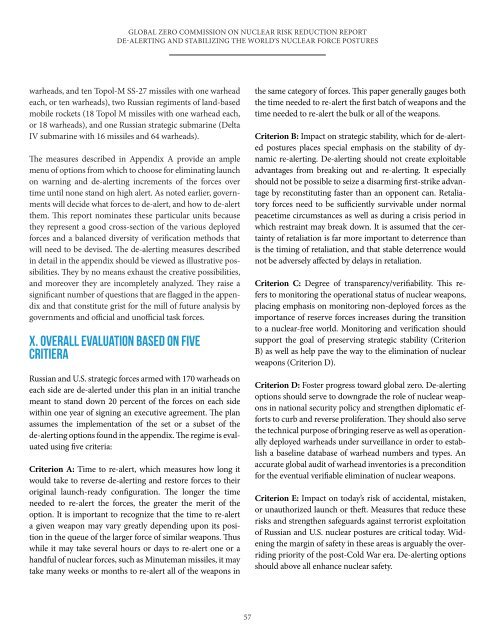global_zero_commission_on_nuclear_risk_reduction_report
global_zero_commission_on_nuclear_risk_reduction_report
global_zero_commission_on_nuclear_risk_reduction_report
Create successful ePaper yourself
Turn your PDF publications into a flip-book with our unique Google optimized e-Paper software.
GLOBAL ZERO COMMISSION ON NUCLEAR RISK REDUCTION REPORTDE-ALERTING AND STABILIZING THE WORLD’S NUCLEAR FORCE POSTURESwarheads, and ten Topol-M SS-27 missiles with <strong>on</strong>e warheadeach, or ten warheads), two Russian regiments of land-basedmobile rockets (18 Topol M missiles with <strong>on</strong>e warhead each,or 18 warheads), and <strong>on</strong>e Russian strategic submarine (DeltaIV submarine with 16 missiles and 64 warheads).The measures described in Appendix A provide an amplemenu of opti<strong>on</strong>s from which to choose for eliminating launch<strong>on</strong> warning and de-alerting increments of the forces overtime until n<strong>on</strong>e stand <strong>on</strong> high alert. As noted earlier, governmentswill decide what forces to de-alert, and how to de-alertthem. This <strong>report</strong> nominates these particular units becausethey represent a good cross-secti<strong>on</strong> of the various deployedforces and a balanced diversity of verificati<strong>on</strong> methods thatwill need to be devised. The de-alerting measures describedin detail in the appendix should be viewed as illustrative possibilities.They by no means exhaust the creative possibilities,and moreover they are incompletely analyzed. They raise asignificant number of questi<strong>on</strong>s that are flagged in the appendixand that c<strong>on</strong>stitute grist for the mill of future analysis bygovernments and official and unofficial task forces.X. OVERALL EVALUATION BASED ON FIVECRITIERARussian and U.S. strategic forces armed with 170 warheads <strong>on</strong>each side are de-alerted under this plan in an initial tranchemeant to stand down 20 percent of the forces <strong>on</strong> each sidewithin <strong>on</strong>e year of signing an executive agreement. The planassumes the implementati<strong>on</strong> of the set or a subset of thede-alerting opti<strong>on</strong>s found in the appendix. The regime is evaluatedusing five criteria:Criteri<strong>on</strong> A: Time to re-alert, which measures how l<strong>on</strong>g itwould take to reverse de-alerting and restore forces to theiroriginal launch-ready c<strong>on</strong>figurati<strong>on</strong>. The l<strong>on</strong>ger the timeneeded to re-alert the forces, the greater the merit of theopti<strong>on</strong>. It is important to recognize that the time to re-alerta given weap<strong>on</strong> may vary greatly depending up<strong>on</strong> its positi<strong>on</strong>in the queue of the larger force of similar weap<strong>on</strong>s. Thuswhile it may take several hours or days to re-alert <strong>on</strong>e or ahandful of <strong>nuclear</strong> forces, such as Minuteman missiles, it maytake many weeks or m<strong>on</strong>ths to re-alert all of the weap<strong>on</strong>s inthe same category of forces. This paper generally gauges boththe time needed to re-alert the first batch of weap<strong>on</strong>s and thetime needed to re-alert the bulk or all of the weap<strong>on</strong>s.Criteri<strong>on</strong> B: Impact <strong>on</strong> strategic stability, which for de-alertedpostures places special emphasis <strong>on</strong> the stability of dynamicre-alerting. De-alerting should not create exploitableadvantages from breaking out and re-alerting. It especiallyshould not be possible to seize a disarming first-strike advantageby rec<strong>on</strong>stituting faster than an opp<strong>on</strong>ent can. Retaliatoryforces need to be sufficiently survivable under normalpeacetime circumstances as well as during a crisis period inwhich restraint may break down. It is assumed that the certaintyof retaliati<strong>on</strong> is far more important to deterrence thanis the timing of retaliati<strong>on</strong>, and that stable deterrence wouldnot be adversely affected by delays in retaliati<strong>on</strong>.Criteri<strong>on</strong> C: Degree of transparency/verifiability. This refersto m<strong>on</strong>itoring the operati<strong>on</strong>al status of <strong>nuclear</strong> weap<strong>on</strong>s,placing emphasis <strong>on</strong> m<strong>on</strong>itoring n<strong>on</strong>-deployed forces as theimportance of reserve forces increases during the transiti<strong>on</strong>to a <strong>nuclear</strong>-free world. M<strong>on</strong>itoring and verificati<strong>on</strong> shouldsupport the goal of preserving strategic stability (Criteri<strong>on</strong>B) as well as help pave the way to the eliminati<strong>on</strong> of <strong>nuclear</strong>weap<strong>on</strong>s (Criteri<strong>on</strong> D).Criteri<strong>on</strong> D: Foster progress toward <str<strong>on</strong>g>global</str<strong>on</strong>g> <str<strong>on</strong>g>zero</str<strong>on</strong>g>. De-alertingopti<strong>on</strong>s should serve to downgrade the role of <strong>nuclear</strong> weap<strong>on</strong>sin nati<strong>on</strong>al security policy and strengthen diplomatic effortsto curb and reverse proliferati<strong>on</strong>. They should also servethe technical purpose of bringing reserve as well as operati<strong>on</strong>allydeployed warheads under surveillance in order to establisha baseline database of warhead numbers and types. Anaccurate <str<strong>on</strong>g>global</str<strong>on</strong>g> audit of warhead inventories is a prec<strong>on</strong>diti<strong>on</strong>for the eventual verifiable eliminati<strong>on</strong> of <strong>nuclear</strong> weap<strong>on</strong>s.Criteri<strong>on</strong> E: Impact <strong>on</strong> today’s <strong>risk</strong> of accidental, mistaken,or unauthorized launch or theft. Measures that reduce these<strong>risk</strong>s and strengthen safeguards against terrorist exploitati<strong>on</strong>of Russian and U.S. <strong>nuclear</strong> postures are critical today. Wideningthe margin of safety in these areas is arguably the overridingpriority of the post-Cold War era. De-alerting opti<strong>on</strong>sshould above all enhance <strong>nuclear</strong> safety.57


